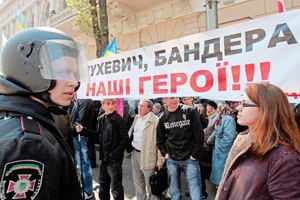Ukraine commemorates fighters of the anti-Stalin resistance

October 14 is an important day for many Ukrainians. The Ukrainian Insurgent Army (UPA) was founded 68 years ago. On this day hundreds of official and unofficial activities to honor the UPA warriors are held in all Ukraine.
It is notable that not long before this anniversary Mikhail Fedotov, the new advisor to Dmitry Medvedev, stated that de-Stalinization of Russian consciousness was his first priority. In this case we fully support the administration of the Russian president. Moreover, this is what Ukraine has been trying to do for many years. Recognizing the UPA warriors a party in the war, undoubtedly, will be one of the stages of the de-Stalinization. Though the historical education of the current Ukrainian authorities is iffy, no doubt the present government will become aware of the necessity of this step.
Meanwhile, the anniversary of the UPA is once again celebrated before elections. This means that instead of reflecting on the deep drama of this page in our history, Ukrainians will again observe political activities, conflicts, and confrontations. Instead of educational programs and unbiased documentaries about the activities of the UPA, all domestic television channels will show brutal faces of activists of odious political forces. It is symbolic that before the 68th anniversary of the creation of the Organization of Ukrainian Nationalists-Ukrainian Insurgent Army (OUN-UPA) in Sevastopol (the majority of its population does not possess any information about this organization other than Soviet stereotypes) the exhibit “Ukrainian Righteous Men. Volhynian Massacre: Victims of the OUN-UPA” is held, which is supposed to arouse animosity among the unprepared population. This is our reality 19 years after we gained independence.
However, fortunately, there is another side of the Ukrainian reality. This side consists of professional historians, journalists, and public activists capable of critical thinking. Those who distinguish between the historical truth and temporary political expediency. These people write books, study archival documents, deliver lectures. By the way, the exhibit For Our Native Land, for Cossacks’ Customs opened in the Ternopil archives, reports Larysa Osadchuk. The exposition contains archival documents of criminal cases against members of the OUN-UPA, lists of members of the underground organization, leaflets, and recollections. Unfortunately, this exhibit will not be displayed in Luhansk or Sevastopol.
An interesting meeting will also take place today at Lysonia Hill, in the Berezhany district of the Ternopil region. Lysonia is a very symbolic place for Ukrainian underground movement. In September 1916 an extremely difficult battle between the Ukrainian Sich Riflemen against the Russian army took place here. In the 1920s a burial mound was formed here to commemorate the perished soldiers, which became a cause for conflict with the Polish government. Soon after in Lviv, on June 1941, the Act on Renewing the Ukrainian State was proclaimed, a meeting of many thousands was held at Lysonia, Ukrainians from all parts of Galicia came there. After this event the German occupational government banned holding such manifestations at Lysonia Hill. The Soviet government also severely fought to eliminate from the memory of Ukrainians any recollections about the heroism of the Ukrainian people in their aspiration for independence. In the 1970s the burial at Lysonia was hardly protected from ploughing it up for agricultural purposes. VO-3 “Lysonia” was the name of the military district within the UPA-West on the territory of the Ternopil region to the Dniester.
It is not difficult today to learn about such places and facts from the history of the OUN-UPA, etc. The main thing is to look beyond the diagonal of your TV-set, and of course, to be willing to learn more than you are offered before the elections.






